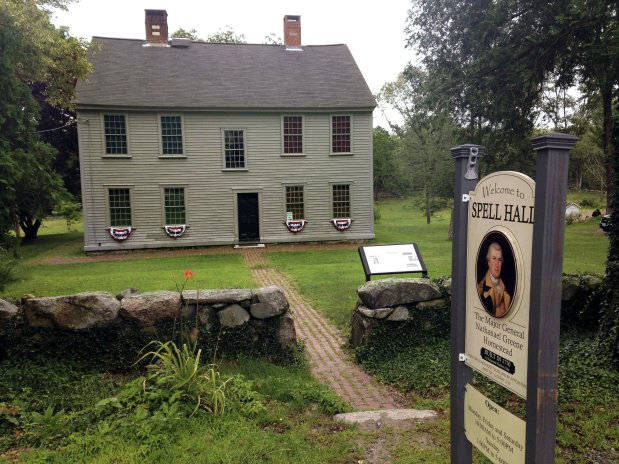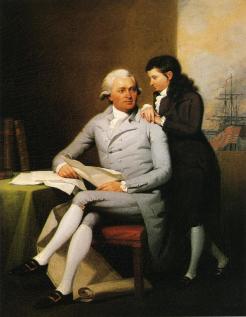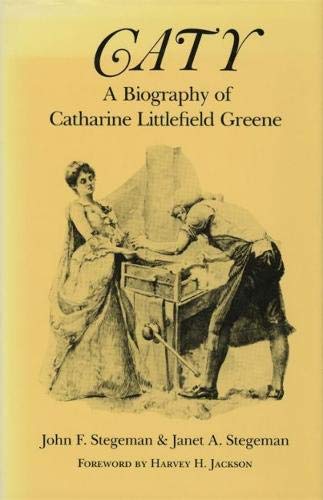The introduction begins with a scholarly look at the feminine sphere of women during the colonial period and society’s disapproval of women who were perceived to have stepped outside of it pre- and post- American Revolution. Caty Greene often defied this narrow perception of acceptable behavior. She also shouldered heavy financial burdens who her husband, General Nathanael Greene, one of George Washington’s most trusted and capable generals, shouldered as a direct result of the war until his early death in 1786.
Caty burned all her letters to Nathanael therefore their relationship is interpreted through Nathanael’s letters and responses to her.

Review:
May 1761, six-year-old Caty Littlefield watched her mother’s burial on Block Island off the coast of Rhode Island, an isolated place where her ancestors had lived since the 1660’s free from Massachusetts dogma. Two years later, Caty was taken in by her namesake, her mother’s sister Catharine Greene, a dark-haired violet-eyed beauty who Caty resembled. Aunt Catharine was married to William Greene, Jr. a Rhode Island politician who was distantly related to Nathanael Greene. Nathanael was a frequent visitor to the house in East Greenwich.

The Caty Nathanael met there was comfortable in the society of men and her “power of fascination was absolutely irresistible.” Nathanael and Caty wed on July 20, 1774. They settled in his home in Coventry, Rhode Island, but those early days of tranquility were short lived. The events in Massachusetts on April 19, 1775 changed all that and Nathanael left with Rhode Island militia to attend the siege of Boston.

Caty was determined to spend time with her husband at camp no matter where that was. Pregnant, she traveled to Nathanael’s headquarters west of Boston. When she returned to Coventry, her lack of domestic skills, fear for Nathanael’s safety and pregnancy led to personal anxieties. She squabbled with her female in-laws.
Caty visited her husband at his headquarters as often as possible, with or without her children. As a general’s wife, she was naturally made the center of attention. She became close friends with Martha Washington and Lucy Knox. Her vivacious behavior elicited a spontaneous response from admiring gentlemen. She listened with genuine interest to stories told by men like General Israel Putnam. Young aides became smitten with her looks and playfulness, and Nathanael was delighted by their admiration.
In late spring 1776, whispers about Caty’s behavior circulated among her family members. In the winter of 1777, jealousies and insecurities surfaced between Caty and Nathanael—his admiration for Lady Stirling and Kitty, General Alexander Stirling’s wife and daughter, his reminder to watch her spelling when writing to the scholarly Lucy Knox, and his subsequent letter after he heard about Caty’s many parties:
“In the neighborhood of my quarters there are several sweet pretty Quaker girls. If the spirit should move and love invite who can be accountable for the consequences?”
Leaving her children with in-laws, Caty arrived in Valley Forge in 1778 where she met men like Lafayette, Steuben, and Hamilton while her jealousy simmered over the Stirling ladies. It was here she met General Anthony Wayne. An incurable ladies man, his wife never came to camp. Caty was stimulated by the company of this charming man. The whispered gossip began yet Nathanael remained unconcerned.

By the summer of 1780, she was back in Coventry. Nathanael’s new post was uncertain. Then, he was sent off to the deep South. The Greene’s had no cash; only land in Rhode Island. While Nathanael bore the horrors of the Southern Campaign, forbidding Caty to join him, she was enjoying the social life in Newport among French soldiers.
After the British surrender in Yorktown, Virginia in October 1781, she traveled to South Carolina to join Nathanael at his headquarters near Charleston. She witnessed the devastation Nathanael had warned her of. After a twenty-three month separation, she found her husband much changed and worn down from the war and debt. Only land grants for his service in the Southern campaign stood between their family and utter financial ruin—Mulberry Grove plantation and holdings on Cumberland Island off the coast of Georgia. Anthony Wayne was granted the plantation adjacent to Mulberry Grove.
In 1785, Caty gave birth to their sixth child, Catharine. The infant died of whooping cough. Caty lay for weeks despondent. Nathanael hired a tutor for the children, a twenty-one year old graduate of Yale, Phineas Miller. The family moved to Mulberry Grove in November. Caty was pregnant again. Tragically in April 1786, she fell and gave birth to a premature daughter who died soon after.
By then, the Mulberry Grove plantation was thriving. The Greenes had a promising new start which came to an abrupt end on June 19, 1786, when Nathanael died of sunstroke. Caty soon learned the worst. Her husband died before he had made the barest beginning toward paying off the huge debts he owed to his creditors after borrowing money to equip his Southern Army. She would have to make a claim of indemnity to the government for reimbursement.
She poured her heart out to Jeremiah Wadsworth, one of Nathanael’s creditors and a man she had been attracted to for years. Wadsworth was married and had past indiscretions. Jealousy ignited between Miller and Wadsworth for Caty’s affections and Wadworth’s support in settling her estate in Congress began to wane.

In 1791, she stood before Congress with her indemnity claim that Alexander Hamilton had helped her prepare. Anthony Wayne held a seat in Congress and fought furiously for her settlement. On April 27, she was awarded $47,000 and for the first time since the war, her family was solvent. Soon after, Wayne disappeared from her life. He went west to join the military there. He died of complications from gout on December 15, 1796 during a return trip to Pennsylvania from a military post in Detroit.
By this time, Caty and Phineas Miller had drawn up a legal agreement concerning their relationship and prospective marriage. All five of her children were living at Mulberry Grove, but her oldest child, George, drowned soon after coming home from France.

Enter Eli Whitney, who came south to accept a teaching position. Miller and Whitney formed a business partnership with Caty as a silent backer to finance Whitney’s cotton gin invention. However, the venture needed more capital than Caty could provide. Caty and Phineas invested in a land scheme—the Yazoo Company. The company collapsed and Caty once again faced poverty. She married Phineas later that year much to Whitney’s chagrin for he was in love with her.
In 1800, Mulberry Grove was sold and the family moved to Cumberland Island at Dungeness where Nathanael, fourteen years before, had begun construction of his family’s future home. The island yielded everything the family needed to survive, but three years later at age thirty-nine, the gentle and faithful Phineas died of blood poisoning after pricking his finger on a thorn.
Caty was faced with selling Phineas’ part of the Miller estate which was tied up in his company with Whitney. There were also the settlements against her estate for legal fees, loans, etc. For a time, she sold live oaks to a lumber company in an effort to salvage the cotton gin company.
Eli Whitney was tormented by his love for Caty, but she was now past childbearing age and he wanted a family. She made a failed attempt at matching him with her youngest daughter, Louisa. On July 5, 1814, Caty wrote her last letter to Whitney who was in New Haven, Connecticut:
“We have a party of eighteen to eat Turtle with us tomorrow. I wish you were the nineteenth. Our fruit begins to flow in upon us—to partake of which I long for you… ”
She had grown and found as Nathanael once suggested, that self-pity made a sad companion. In the last week of August, Caty was struck with a fever. The same week the capital city of Washington lay in ruins. Caty never knew. She died on September 2, 1814.

Despite history’s proverbial finger pointing about what she may have done during her marriage to Nathanael, I highly recommend this book that highlights the strengths and weaknesses of a woman who faced the consequences of war and met them head on the rest of her life.











 Flight of the Sparrow: A Novel of Early America
Flight of the Sparrow: A Novel of Early America